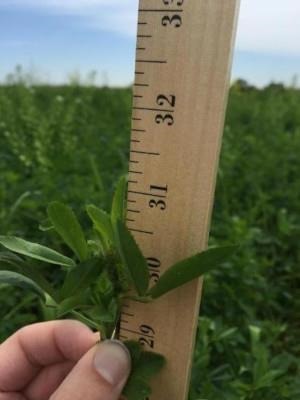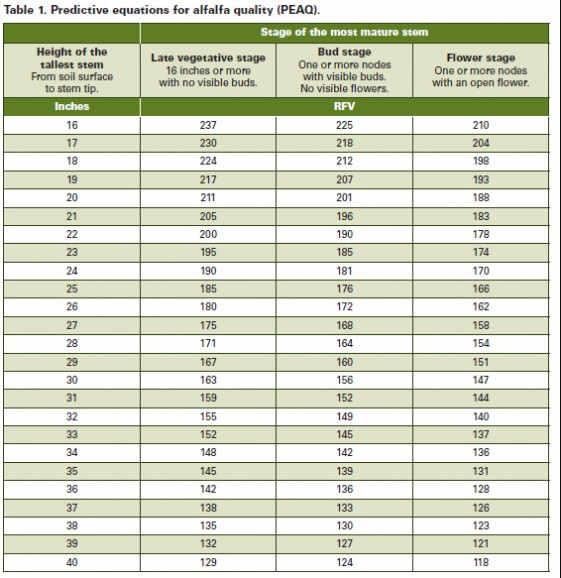By Joshua Michel
The growth and development of alfalfa is affected by many factors, including temperature, soil moisture, stand age and even cultivar. Alfalfa growth has been slower than normal due to cool conditions in April. This is a good reminder that using a calendar date to determine when to harvest the first crop of alfalfa may not the best method. In order to accurately predict the optimal time for the first cutting, the University of Wisconsin developed the Predictive Equations for Alfalfa Quality (PEAQ) method.
The PEAQ method uses alfalfa stand height and maturity stage (vegetative, bud, or open flower) to estimate the relative feed value (RFV). In general, it is recommended to harvest alfalfa at about 150 RFV for milking dairy herds and 125 RFV for heifers, stocker cattle, and lactating beef cattle. First crop alfalfa left standing in the field can drop three to five RFV points per day. The steps on how to use the PEAQ method to determine when to make the first crop of alfalfa are listed below.

While PEAQ provides a good estimate of RFV, adjustments for harvest loss should also be made. Even under the best harvest conditions, 10-20% of the forage dry matter will be lost at harvest. This amounts to approximately 15 RFV points for haylage and 25 RFV points for hay. Therefore, to end up with 150 RFV alfalfa, harvest the crop when PEAQ measurements estimate a RFV of 165 for a haylage harvest and 175 for a hay harvest. Additionally, weather forecasts and allowing proper drying time should be considered when deciding when to harvest alfalfa.
Steps for using PEAQ to determine when to take first crop alfalfa
Step 1. Choose a representative two square foot area in the field.
Step 2. Determine the stage of the most mature stem in the area by using the definitions at the top of Table 1.
Step 3. Measure the tallest stem in the area. The tallest stem may not be the most mature stem. Measure the stem from the soil surface to the tip of the stem; not to the tip of the leaf. Straighten the stem for an accurate height measurement. Based on stem maturity and stem height, use Table 1 to estimate the RFV of standing alfalfa crop.
Step 4. Repeat steps 1-3 in five representative areas across the field.
Step 5. To estimate harvest quality, subtract 15-25 RFV units to account for harvest losses during the haylage or hay harvest process, respectively.
Step 6. Determine optimum harvest time using the PEAQ estimate, livestock forage quality needs, considerations of upcoming weather forecasts favorable for harvest and drying, and the general assumption that RFV drops three to five points per day.
Iowa State University Extension and Outreach maintains a PEAQ website that includes a fact sheet to explain how to use the PEAQ method to determine when to harvest first crop alfalfa. This website also includes postings of PEAQ values from some alfalfa fields across Iowa being monitored by ISU Extension and Outreach staff. Follow the progress in these reports but remember conditions can vary field-by-field. Therefore, it is recommended to take PEAQ measurements in your own fields for the best assessment of when to harvest alfalfa for the quality of forage you wish to achieve.

Source : iastate.edu